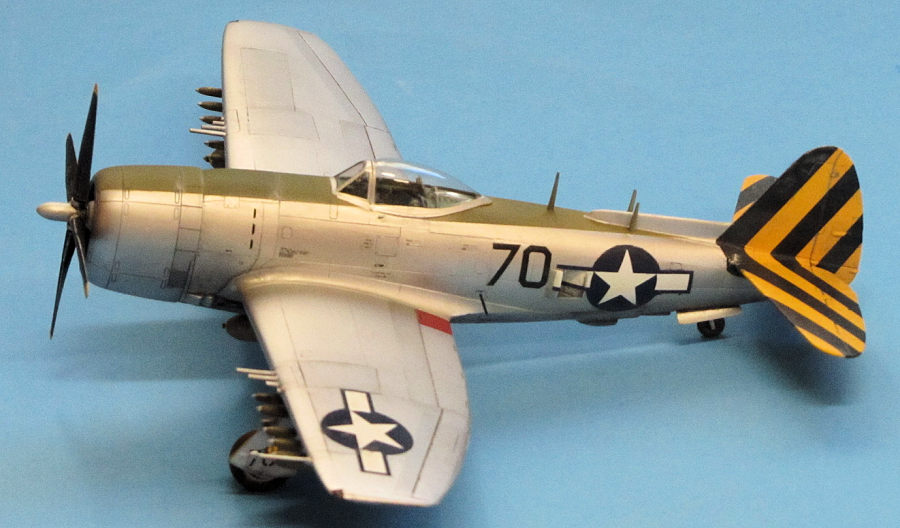
High Planes 1/72 P-47N Thunderbolt
| KIT #: | 72022 |
| PRICE: | $20-25.00 |
| DECALS: | Two Options |
| REVIEWER: | Ryan Grosswiler |
| NOTES: | I kinda cheated |

| HISTORY |
A museum guide once told my group sauntering along with him that the P-51 started out as a ground attack plane and became an excellent fighter, and that the P-47 started out as a fighter which became an excellent ground attack plane. Broad brush strokes, yes, but not a bad generalization for a bunch of neophytes that happened to have a closet vintage aircraft buff in their midst.
The P-47 was actually the final expression of Alexander de Seversky's groundbreaking theories of the future of air power. Actually sketched out in 1940 by fellow Soviet emigre and sometime business partner Alexander Kartveli, the P-47 had an epileptic design phase as changes demanded by the AAF--in turn based on observations of the new war exploding in Europe--saw the requirements and projected form revised so many times that the first prototype P-47 was actually the "B" model. More changes were demanded on the early production so quickly that the result was that the "D" was the almost sole wartime model, even as the letter designator for some reason did not change when the airframe went from fastback to a bubble canopy. Never a good airplane in turning fight, the fighter groups in Europe gradually phased it out in favor of the P-51 during 1944.
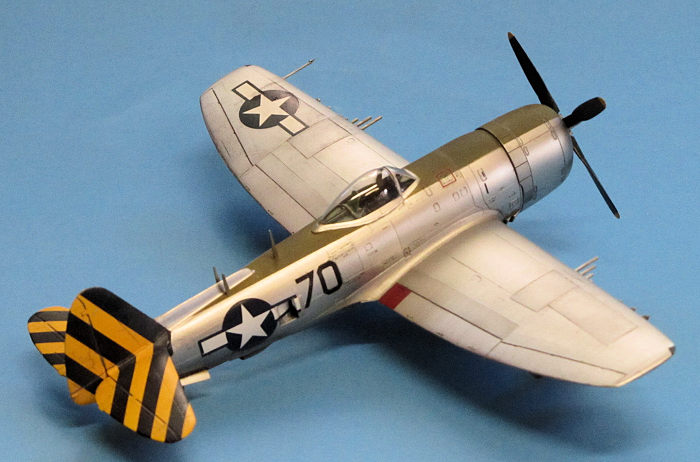 However, with all the power from that efficient turbocharger, the P-47 was
still fast in a straight line at high altitudes, and to deal with the threat
posed by the weird new Luftwaffe jet and rocket fighters suddenly making
their appearance, the fighter was fitted with a souped-up version of its
R-2800 engine and a bigger prop, which boosted its top speed by 40 knots.
This was the P-47M, seeing service in the last weeks of the war in Europe.
However, with all the power from that efficient turbocharger, the P-47 was
still fast in a straight line at high altitudes, and to deal with the threat
posed by the weird new Luftwaffe jet and rocket fighters suddenly making
their appearance, the fighter was fitted with a souped-up version of its
R-2800 engine and a bigger prop, which boosted its top speed by 40 knots.
This was the P-47M, seeing service in the last weeks of the war in Europe.
War planners were looking ahead at the unfinished campaign against Japan. The Thunderbolt was always a long-legged fighter, having been fitted early with jettisonable tanks, but even longer range would be needed for the vast stretches of the Pacific. The third P-47M was therefore fitted with an entirely new wing with a squarish tip, stretched not at the tips but at the root, and with a less pronounced ellipse. Wet, meaning that the entire structure was sealed off and the whole interior of the wing was the fuel tank (one of my references says it was instead given four new tanks). The spike in max gross takeoff weight necessitated bigger, beefier main landing gear and wheels/tires, upgraded hydraulics, and various other minor changes. All this resulted in a max gross takeoff weight of over 20,000 lbs., fully three times the weight of the Japanese fighters that would be coming at it.
In an illustration to how fluidly design, requirements, and engineering worked between contractor and customer during the period, development took just three months from prototype to production across the summer into autumn of 1944. The first P-47Ns were pushed forward several months later in time for the war in...Europe! Actually, they hadn't been fully uncrated and reassembled yet when May 8 rolled around and the shooting stopped, so those were packed up again and sent back the other way to the fighting still raging in the Pacific, where other Ns had already been arriving since March.
Flying from Ie Shima, Iwo Jima, and Okinawa, the Ns quickly distinguished themselves in combat both air-to-air and air-to-ground, especially considering how short a period they were at the front. Two pilots, Oscar Perdomo and John Vogt, became 'ace in a day' on the sub-type, as the last great Double-you Double-you Two air battles were fought preparatory to the anticipated invasion of Kyushu planned for November of 1945. Obviously, things came to an unexpected screeching halt towards the end of summer. Postwar, these final P-47s saw service for about ten years in various National Guard units.
| THE KIT |
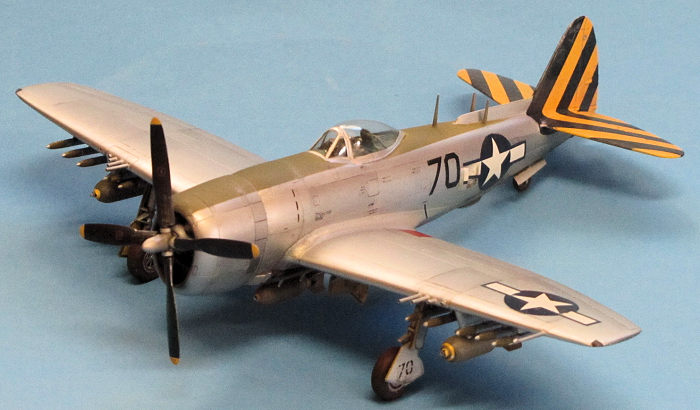 Let's just get this out of the way: at the dawn of the year 2021, there is
still no easy means of getting your Ultimate T-bolt in 1/72.
Let's just get this out of the way: at the dawn of the year 2021, there is
still no easy means of getting your Ultimate T-bolt in 1/72.
What are the options? For mainstream injected you have the miserable Heller kit, with its weird proportions and supercritical airfoil, and the equally miserable Italerei release, also with weird proportions (as one perceptive reviewer pointed out on this site, the box art is visibly more accurate than the kit within), which manages to add miserable construction, too.
Quietly, in the background of this True Modelling Tragedy, High Planes came to the rescue around 1998 with this release. Very much an early-generation short-run kit, you receive about 18 light blue injected components, a set of white metal main gear, resin wheels, and a vacuform canopy. High Planes always put a lot of effort into accuracy, and some really nice parts emerge when one spends the time to unearth them from those massive, sloppy, ugly sprues. But short run is still short run, and this model is unavoidably going to be natural-metal finish to boot.
Sword has put out in the intervening years a P-47N that, going by my experience with this firm's products, probably looks good when done, but--bear in mind--this newer product is STILL a short-run injected kit, with all trials and tribulations implied.
| CONSTRUCTION |
I started out the project fully intending on this being just a straightforward construction of the High Planes release, and duly packed it with the rest of my stuff on my way out for a long overseas deployment. While rummaging for the kit, however, I ran across Tamiya's "D". A crazy thought crossed my mind: would I save time (and produce a better model) by "cross-kitting" Tamiya's fuselage with High Planes wings?
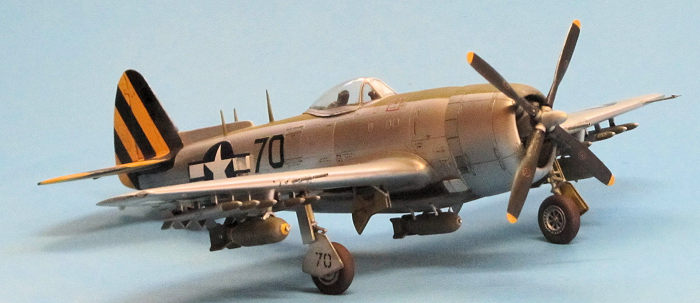 The case was strong: Tamiya's P-47 is one of the best 1/72 kits--ever, with
high accuracy, excellent fit, and resin-like cockpit detail. No matter how
much time I put into it, I could never make the High Planes cowling look as
nice as Tamiya's single piece molding with its equally nice internal intake
ducting. Finally, I very much prefer in my modelling to make all variants of
the same aircraft type from the same set of molds, so they look as
consistent in a group as possible.
The case was strong: Tamiya's P-47 is one of the best 1/72 kits--ever, with
high accuracy, excellent fit, and resin-like cockpit detail. No matter how
much time I put into it, I could never make the High Planes cowling look as
nice as Tamiya's single piece molding with its equally nice internal intake
ducting. Finally, I very much prefer in my modelling to make all variants of
the same aircraft type from the same set of molds, so they look as
consistent in a group as possible.
A menacing question remained, however: could the parts from these two very different kits be made to play together?
Question unanswered, the Tamiya sprues were de-boxed and joined the High Planes kit, taking up precious cargo space with my Aviation Usk B-32 wedged in between the plates of my body armor. In I went on a C-17 which took me to the antipodes over the course of a week. Looking over the contents after arrival and settle-in, I developed the following approach: the fuselage and tail would come from the Tamiya kit, whereas High Planes would offer the wings, landing gear, wheels, and dorsal fin extension.
To cut to the chase, the basic "cross-kit" work itself turned out to be actually pretty easy. I started by building up the D fuselage, replicating Tamiya's cockpit floor in plain styrene along the way as the P-47's characteristic corrugated floor was replaced with plain metal sometime late in the D's production. The High Planes fin extension, unique to the N, was excised and faired carefully on to Tamiya's upper rear fuselage parts. As this was going on, I carefully sanded down the High Planes wings to get nice, thin trailing edges.
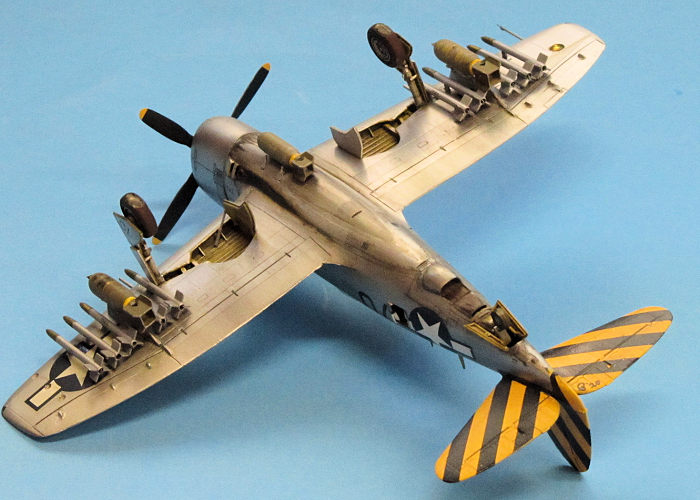 Fuselage done and closed up, I started the conversion proper by fitting the
upper halves of the N wings to the D fuselage, compulsively checking both
sweep and dihedral repeatedly against 1/72 plans as I did so. Wouldn't be a
smart move to assemble the wings and then try and fit them, as it turned out
that Tamiya's stub wing spar (Part A1) needed its height reduced a little to
accommodate High Planes' thicker short-run plastic, and the root of the N
wing needed to be bent a bit to match the fuselage fillet's upper camber
where they mated. I sanded the interior of the wing smooth to take gear-well
detail later, then glued only the wing tops at this time, again carefully
checking sweep and span, and left it in a simple jig to cure overnight.
Fuselage done and closed up, I started the conversion proper by fitting the
upper halves of the N wings to the D fuselage, compulsively checking both
sweep and dihedral repeatedly against 1/72 plans as I did so. Wouldn't be a
smart move to assemble the wings and then try and fit them, as it turned out
that Tamiya's stub wing spar (Part A1) needed its height reduced a little to
accommodate High Planes' thicker short-run plastic, and the root of the N
wing needed to be bent a bit to match the fuselage fillet's upper camber
where they mated. I sanded the interior of the wing smooth to take gear-well
detail later, then glued only the wing tops at this time, again carefully
checking sweep and span, and left it in a simple jig to cure overnight.
The bottoms of the wings were then triple-checked and glued. The High Planes wings are engineered a little differently on the bottom than Tamiya's and come up short, so I bridged the 3/16" gap with styrene sheet and epoxy putty. This was then sanded to shape, and the whole fuselage-wings assembly sanded down to a consistent 2000 grit. Detail was added to the gear wells with the usual styrene and stretched sprue. Conversion complete. So far, so good. It was the little nit-noids that would suck up 75% of the completion time on this project.
The first item was to get the gun barrels lined up horizontally. This required making up a little template to tape to the front of the wings for pilot holes which were eventually widened to accept Albion Alloys brass tube. Next, I bedded some K&S aluminum tube in the wings with J&B Weld to eventually serve as receptacles for the landing gear. Then the canopy and tailplanes were added, along with the triad of VHF antennas around the dorsal fin, and then the pitot tube.
| COLORS & MARKINGS |
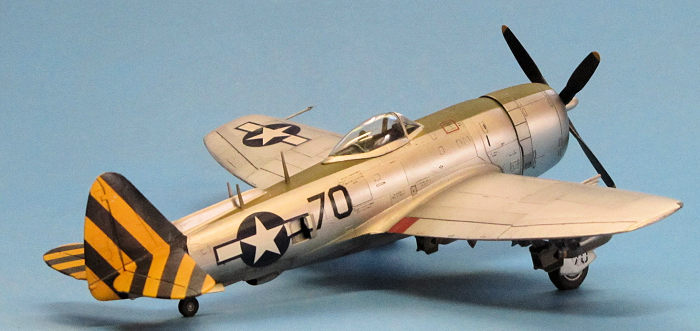 I had two stipulations for the way I wanted to finish this model: 1) the
garish yellow-and-black tail chevrons of the xxx Squadron/318th Fighter
Group, and 2) a maximum load of bombs and rockets. This was the most
heavily-armed single engine fighter until the advent of the F-105.
I had two stipulations for the way I wanted to finish this model: 1) the
garish yellow-and-black tail chevrons of the xxx Squadron/318th Fighter
Group, and 2) a maximum load of bombs and rockets. This was the most
heavily-armed single engine fighter until the advent of the F-105.
Complying with the second requirement dictated a Block 5 aircraft, which only were just beginning to reach the theater by war's end. I searched far and wide for photos of an example in an operational setting. I finally found one of aircraft "70" photographed over three frames on both sides and with a closeup of the underwing stores. Anonymous, except painted on the left side of the cowl a marvelous kneeling beauty which I would make no attempt to replicate. These photos showed a full fit of ten HVARs, a 1000-lb GP on each wing pylon, and a 500-lb GP stuck on the centerline rack, almost like an afterthought. This is in addition to the standard eight '50s. Did I mention this variant had firepower?
A base coat of Testor's Gloss Black was applied to serve as base coat for the Alclad White Aluminum, as I'd had a horrendous experience with a bottle of Alclad's own black primer earlier which nearly ruined my Usk B-32 after 400 hours of work. This time the experience went much better, and a few contrasting panels were then applied, followed by the OD anti-glare panels.
While I was working on the markings, a mix of Superscale,
Tamiya, and spares box, I made up the weapons stores. The 500-lb GP came
from the Tamiya kit while the 1000-pounders were True Details, and the HVARs
from Dragon's P-38. I took the time to stencil them with de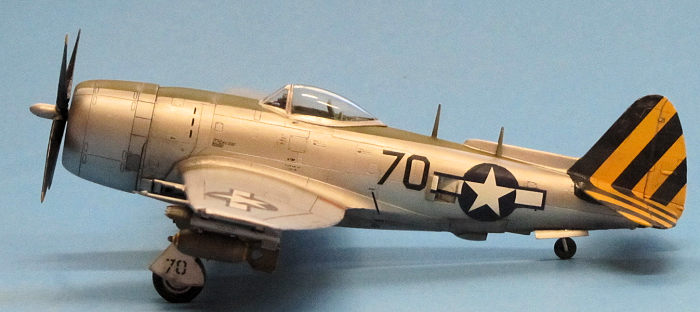 cals
and give the bombs the scruffy, blotchy look of the actual finish of
ordinance in theater.
cals
and give the bombs the scruffy, blotchy look of the actual finish of
ordinance in theater.
The landing gear and wheels, already painted and weathered, were then mounted with more J&B Weld. I took ten minutes to make up a simple balsa jig to make sure the airplane sat at the correct angle while I lined up everything underneath square and straight and left it to cure overnight.
A slight weathering was applied and kept very light on top. The belly was a different matter. I studied wartime pictures closely and realized that all P-47s quickly got really grubby and oily beneath, seemingly the moment the powerplant was first fired up, with an especially prominent and stark pair of streaks--almost scorch marks--stretching aft from the waste gate outlets beneath the wing leading edge. I built all this up over several modelling sessions, starting with the oil streaks, then the light sooty exhaust airbrushed in a thinned off-white, and finally those waste gate streaks from rendered artists' oils.
Inner gear doors and ordinance were hung, a few last touches applied, and I was ready to sweep this time-eater off the workbench!
| CONCLUSIONS |
| REFERENCES |
14 May 2021
Copyright ModelingMadness.com. All rights reserved. No reproduction without express consent.
If you would like your product reviewed fairly and fairly quickly, please contact the editor or see other details in the Note to Contributors.